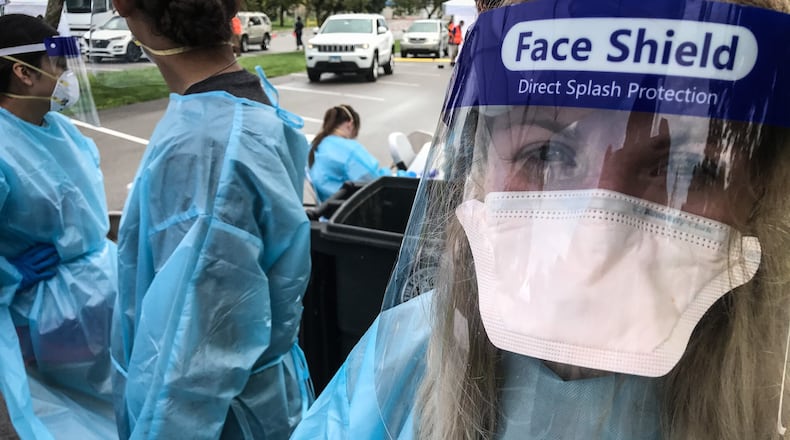In Ohio, about 200,000 COVID-19 cases, 46% of the state’s total cases, occurred in November, according to data from the Ohio Department of Health. The stark numbers are not just a result of increased testing. On Wednesday, Ohio’s seven-day positivity rate surpassed 15%, meaning about 15% of all the COVID-19 tests administered across the state are coming back positive.
On Nov. 6, Ohio reported more than 5,000 COVID-19 cases in one day for the first time.
Then four days later, on Nov. 10, Ohio reported more than 6,000 cases.
The Ohio Department of Health’s website began displaying a disclaimer that data is incomplete because due to “unprecedented volume, thousands of reports are pending review.” Daily records kept getting smashed.
On Nov. 12, more than 7,000 cases were reported; then over 8,000 on Nov. 13. On Nov. 23, it was nearly 12,000 cases .
More than 7,000 people were in Ohio hospitals with COVID in November. That is a quarter of all hospitalizations due to COVID-19 in Ohio since the start of the pandemic.
Why is the spread happening?
Area public health officials said the virus was always expected to flare up in the winter months. Schools reopened in fall, many states rolled back restrictions, and infections began to spread as people resumed small gatherings.
Dan Suffoletto, spokesman for Public Health-Dayton & Montgomery Count, said there is a snowballing effect and “more cases begets more cases.”
Dr. Don Brannen, an epidemiologist at Greene County Public Health, said the spread is happening wherever social distancing and mask wearing is not being practiced adequately.
“This includes gyms, on campus (usually out of class gatherings), sports, in home transmissions before tests results are known, and other areas,” he said in an emailed statement. “There appears to be a very small rate of transmission where social distancing and mask wearing was in place and other protecting measures were used (including use of separate bathrooms for those with positive tests isolating at home, etc.).”
Public health officials said anecdotal evidence from contact tracing cases tells them the spread is often happening among friends and family members. Suffoletto said they saw a bump in cases after Halloween.
The effects of Thanksgiving remain to be seen. People who were exposed last week are being diagnosed this week and if they need hospitalization will start showing up there in one to two weeks.
Kyle Trout, a spokesman for the Clark County Combined Health District, said uncontrollable community spread continues to lead to outbreaks in nursing homes.
Hospitals are not overwhelmed... yet
Active coronavirus hospitalizations in Ohio more than tripled during November, passing the 5,000 mark. About one in four patients in Ohio hospitals are now COVID-19 positive, according to the Ohio Hospital Association.
John Palmer, a spokesman for the Ohio Hospital Association, said the escalation of COVID-19 hospitalizations places more demand on health care workers and resources. Hospitals across the state are being forced to delay elective surgeries and procedures, including within the Premier Health hospital network according to a statement.
Ohio’s hospitals still have available capacity, including about 25% of total inpatient beds, 22% of Intensive Care Unit beds and 60% of ventilators, according to the Ohio Department of Health.
Lisa Henderson, vice president of the Greater Dayton Area Hospital Association, said in an emailed statement, “the recent trends and rising numbers are certainly concerning, but (area hospitals) are working collectively, across hospitals and health systems, to support one another and our community.”
Contact tracers can’t keep up
The recent surge in cases means public health employees are overwhelmed. Most are having trouble notifying people in a timely manner who have come into close contact with a confirmed COVID-19 case.
“Exponential growth in cases over the past several weeks has definitely created a huge backlog in contact tracing,” Montgomery County Health Commissioner Jeff Cooper said in a prepared statement on Thursday.
Health departments have hired additional staff but they still can’t keep up. Butler County General Health District is no longer reaching out to every case’s contacts but sending instructions to individuals who test positive on how to do their own contact tracing.
Due to the large backlog, area health departments are asking anyone who receives a positive COVID-19 test result to reach out to people they may have exposed. All close contacts should quarantine for 14 days.
Suffoletto, spokesman for Public Health-Dayton & Montgomery County, said Wednesday evening there were over 1,000 county residents waiting to be contacted.
November set records in the Miami Valley
- There were 9,922 cases of COVID-19 in Montgomery County in November. That’s more than 40% of all the cases reported in the county all year through of Dec. 1.
- In Greene County there were 3,125 cases in November, or about half of the county’s cases for the year. Of the 74 people who have died of COVID in the county, 30 died in November..
- In Warren County, there were about 4,500 COVID-19 cases reported in November, about half of the county’s total cases during the pandemic.
- About 2,500 cases occurred in Miami County in November, or about half of the county’s cases so far.
- In Butler County, there were 7,183 COVID-19 cases in November, or about 40% of the county’s cases for the year.
- In Clark County, 2,766 COVID-19 cases occurred in November, or about 46% of the county’s cases this year.
Who is getting sick?
Older Ohioans continue to be disproportionately affected by COVID-19, being hospitalized and dying at much higher rates. About 80% of Ohio’s COVID-deaths have been 70 years or older, according to Ohio Department of Health data.
However, no one is immune and about 590 people age 0 to 19 have been hospitalized in Ohio and four have died. About 1,180 Ohioans between 20 and 29 have been hospitalized and 13 individuals in that age range have died.
Where are the hotspots locally?
According to the Ohio Department of Health, the area zip codes with the highest rates of cases compared to population over the last 30 days include:
- 45416 in Trotwood has 6,139 residents and has had over 180 cases in the last 30 days
- 45315 in Clayton has 4,066 residents and has had about 115 cases in the last 30 days
- 45449, parts of Moraine, West Carrolton and Miamisburg, has 17,914 residents and has had about 480 cases in the last 30 days
- 45377 in Vandalia has 15,280 residents and has had over 400 cases in the last 30 days
- 45050, parts of Monroe and Middletown, has 8,773 residents and has had about 218 cases in the last 30 days
- 45066, in and near Springboro, has 24,836 residents and has had almost 600 cases in the last 30 days
- 45440, which includes parts of Beavercreek, Centerville, Kettering, Bellbrook and Sugarcreek Township, has 20,633 residents and has had almost 500 cases in the last 30 days
What can individuals do?
Health officials said Ohioans should not despair but say this outbreak should be a call to action. They are asking Ohioans to re-double their efforts around the basic prevention steps that have been advocated all year:
- Wear a face mask in public.
- Wash hands frequently with soap and water for at least 20 seconds.
- Avoid contact with anyone outside your household.
- Avoid public spaces except for infrequent, necessary trips for supplies like groceries.
- If you have symptoms of COVID-19 or have tested positive for COVID-19, isolate at home away from others for at least ten days after symptoms appeared or you tested positive.
- If you test positive for COVID-19, alert any one you came into close contact with since two days before you had symptoms or tested positive. Close contacts should quarantine for 14 days.
Laurie Fox, spokeswoman for Greene County Public Health, said they are also urging residents to avoid holiday gatherings - as hard as that will be for many.
“We understand these are very difficult and painful decisions to make, particularly given the time of year with the forthcoming holidays,” she said. “But these decisions we make now could potentially affect future celebrations with loved ones.”

